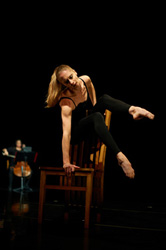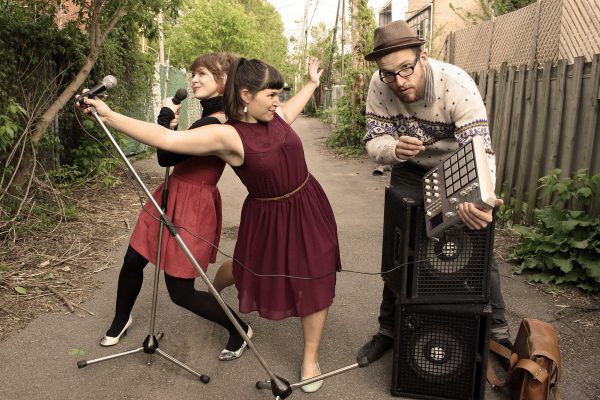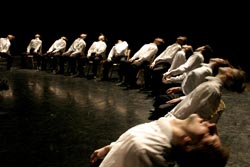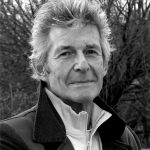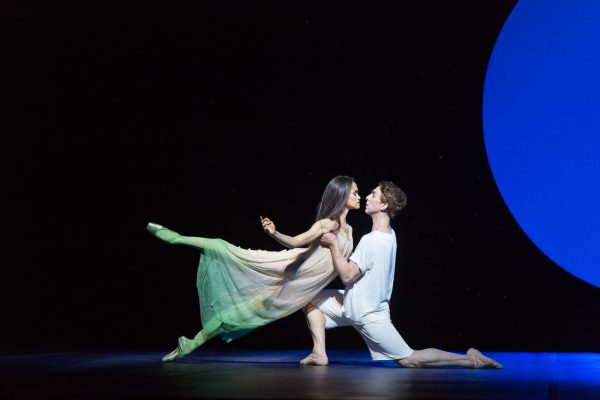As one of Winnipeg’s eagerly anticipated rites of spring, Q Dance’s annual presentation has quickly morphed into a season highlight for local dance lovers. Acclaimed choreographer/founding artistic director Peter Quanz’s latest show at the Gas Station Arts Centre proved no exception, offering three world premieres plus a signature work choreographed by the gifted 32-year-old dance artist.
Q Dance has grown by leaps and bounds since its inception in 2010. Comprised of a crackerjack ensemble of eight Royal Winnipeg Ballet (RWB) dancers handpicked by Quanz, the company recently returned from its inaugural American tour that included performances at St. Louis, Mo.’s Spring to Dance Festival as well as New York City’s Gotham Dance Festival. Notably, the three-year-old troupe, which enjoys a symbiotic relationship with the RWB, was the sole Canadian company to appear at both festivals. Mentored by the RWB’s late artistic director Arnold Spohr, Quanz established a skyrocketing international career after graduating from the RWB School’s Professional Division in 1999. He has worked with an A-list of companies including Russia’s fabled Kirov Ballet, American Ballet Theatre, Les Grands Ballets Canadiens de Montréal, Pennsylvania Ballet and Hong Kong Ballet, among others. He received the prestigious Clifford E. Lee Choreography Award from the Banff Centre in 2005,with his work hailed for its fresh take on classical vocabulary.
The eclectic program began with the simply titled Bach, featuring a live accompaniment of J.S. Bach’s Suites for Unaccompanied Cello performed by Winnipeg cellist Minna Rose Chung. I instantly felt as if I had stumbled onto a secret playground of ballet dancers turned loose. The rollicking contemporary piece, with the eight dancers wearing soft ballet slippers and simple dark bodysuits, begins as a male quartet for Tristan Dobrowney, Alexander Gamayunov, Harrison James and Yosuke Mino. The men dart across the stage, arms stretched outwards to each other before breaking into short solos and duets. The company women — Amanda Green, Emily Grizzell, Sophia Lee and Jo-Ann Sundermeier — then repeat the same playful choreography while infusing it with feminine strength and sensibility. Quanz stamps each section with trademark wit: Green and Sundermeier roll onto the stage before the latter is eventually dragged off by one leg; Mino sits cross-legged, grinning, while listening intently to Chung’s cello; James and the felinesque Lee make peekaboo masks by splaying their fingers over their eyes with mock seriousness. There is scant conventional vocabulary, but that’s really the whole point. Quanz seems to poke fun at the often-serious world of classical dance while defying expectations of how its proponents are “supposed” to behave. I feared the choreography risked becoming eclipsed by all the hijinks at times; however Quanz’s choice to end with Chung’s solo performance of the last suite — sans dancers — underscored the entire ballet with a sense of artistic purity, while adding its own eloquent grace note.
Untitled (Excerpt) is a promising work that will be presented in its entirety next year. Inspired by photographs of an opera house in the former East Germany that was destroyed during the Second World War and later painstakingly rebuilt, the piece is set to Latvian composer Peteris Vasks’ Musica Adventus. It also incorporates Quanz’s own set design. As the work begins, Grizzell sits expectantly on one of seven striking wooden chairs, dramatically lit by Robert Mravnik. Quanz creates a society of dancers who take turns leaping diagonally into each other’s arms, facing downward, with their movement evoking flying, freedom, escape. This leitmotif recurs throughout the intricately choreographed work performed on pointe, until the ensemble erect a wall of chairs around James for the climactic pas de deux. As he sits with his back as poker-straight as the chairs’ wooden slats, Sundermeier reaches her arm backwards to caress his face, as though yearning for human connection. This simple gesture aches with tenderness, and demonstrates Quanz’s growing might as a choreographer. There is no doubt he is able to weave bodies into complex patterns onstage; however when he plumbs greater emotional depths, his ballets gain new resonance. As the two dancers fluidly entwine their limbs, I was reminded of Quanz’s sculptural shapes in his Rodin/Claudel premiered by Les Grands Ballets Canadiens last fall. The final tableau of Untitled where the couple turn away from each other is riddled with ambiguity — and regret — and Quanz wisely allows the viewers to draw their own conclusions.
The oldest piece on the program, In Tandem, is quickly becoming a signature work for Quanz: it was commissioned and premiered by New York City’s Guggenheim Museum Works and Process series in 2009. Set to American composer Steve Reich’s Double Sextet with original lighting by Marc Parent, the dazzling contemporary ballet is propelled forward by its hyperkinetic choreography which is performed on pointe. The full company wearing designer Anne Armit’s graphic bodysuits crisply execute Quanz’s unique movement vocabulary marked by flexed feet, torqued torsos, pulsing pointe work and jutting hips. Dancers break into smaller ensembles, with Lee’s mesmerizing solo a standout for her suspended grace and lyrical port de bras. There are also many surprises, as dancers thrust their legs onstage from the wings, perform cryptic arm movement evoking semaphore code messages and plop themselves on the edge of the stage, thus breaking the fourth wall.
The third premiere on the program, Vlncello, is a deeply personal solo choreographed for longtime RWB principal dancer Vanessa Lawson, exploring her journey through chronic injury. Despite her triumphant return to the stage dancing the lead role in the RWB’s production of Giselle last spring, she continues to be plagued by an injury that sidelined her most of last season.
The searing work features the petite dancer performing mostly while seated on one of the wooden chairs, accompanied by Chung’s meditative cello. The opening choreography is spare and compact, comprised of Lawson widely sweeping her arms through space, avoiding potentially painful jumps and pointe work. Her artistry is so refined she is able to speak volumes even with limited movement and her actual voice is also heard during haunting voice-overs that chronicle her courageous struggle and her personal reflections on the precarious life of dancers when the body begins to fail. Although modern dancers frequently vocalize onstage, ballet dancers seldom do, and hearing Lawson express her need to “find a new way of using her body, her instrument,” which demands “an open heart,” startles with its bold honesty. Many potent images also resonate. When Lawson turns her chair backwards to peer through its vertical slats, it’s as though she is imprisoned by injury. The entry of Dobrowney, Gamayunov, and Mino, who lift her sky-high, serves as a metaphor for dancers carrying — and caring for — their company mates when they stumble. But most harrowing of all is seeing Lawson held aloft with her arms outstretched as though crucified; the raw pain and sacrifice for her art palpable. As the men leave the stage, Lawson returns to her chair, alone, to take one last dignified bow not only for that night’s performance, but an entire glorious career.
Every new company striking out on its own seeks to establish its own identity, and this one is no different. There will invariably be hits and misses along the way. Certain works will resonate, and communicate more effectively than others. Dancers, who inevitably come and go over time, will change the company’s dynamic. And showcasing a single choreographer’s vision can lead to overly homogenous programs. Still, as Q Dance deepens its roots into the fertile loam of Winnipeg’s rich dance community, it continues to grow as an intriguing and inventive ballet company, willing to take creative risks in its own leap of faith.
Tagged: Ballet, Performance, MB , Winnipeg
